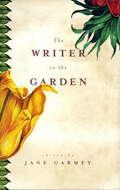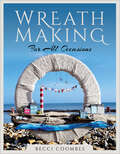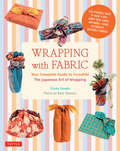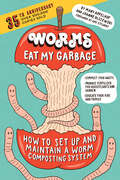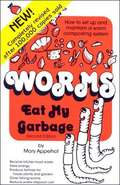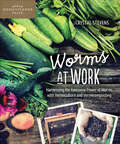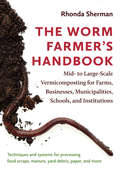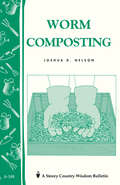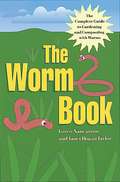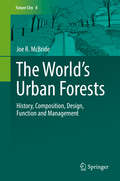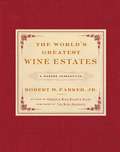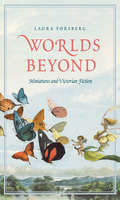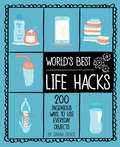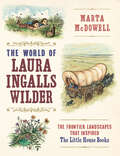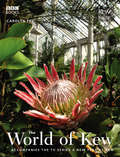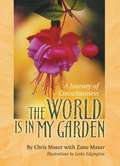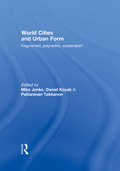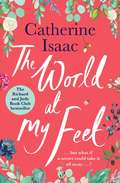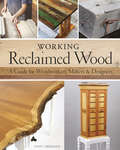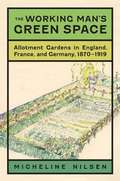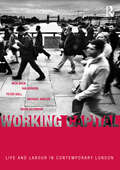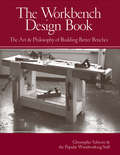- Table View
- List View
The Writer in the Garden
by Jane GarmeyShow me a person without any prejudice of any kind on any subject and I'll show you someone who may be admirably virtuous but is surely no gardener.--Allen Lacy. Idiosyncratic, determined, and occasionally obsessed, gardeners have a lot to say about their outdoor passion. THE WRITER IN THE GARDEN brings together a host of writing gardeners and gardening writers reveling in their quirks, confessing their shortcomings, and sharing their experiences. Combing through a hundred years of garden writing, editor Jane Garmey has discovered some great contemporary works and rediscovered many classics: "I am strongly of the opinion," declares Gertrude Jekyll, "that the possession of a quantity of plants, however good the plants may be themselves and however ample their number, does not make a garden." "It isn't that I don't like sweet disorder, but it has to be judiciously arranged," writes Vita Sackville-West. "Gardeners are--let's face it--control freaks," Abby Adams admits. "Who else would willingly spend his leisure hours wrestling weeds out of the ground, blithely making life or death decisions about living beings, moving earth from here to there, changing the course of waterways?" Drawing on the work of more than fifty writers, THE WRITER IN THE GARDEN covers subjects ranging from the beauty of the garden to ornery weeds, the hazards of rare plant collecting, and the tribulations of inclement weather. The collection includes a range of authors from both sides of the Atlantic: from Edith Wharton, who insists that we could all learn a thing or two about design from the Italians, to Stephen Lacey, who reveals that his most exciting gardening moments are spent in the bath. Some of the other writers in the collection are: E. B. White, Beverly Nichols, Ken Druse, Eleanor Perenyi, W. S. Merwin, Mirabel Osler, Henry Mitchell, Jamaica Kincaid, Robert Dash, Sara B. Stein, Michael Pollan, M.F.K. Fisher, Anne Raver, Patti Hagan, Paula Deitz.
Wreath Making for all Occasions (Make Your Own Ser.)
by Becci CoombesEven a quick walk in the countryside or Sunday stroll along the beach can yield the most interesting and attractive materials for making beautiful decorations for the home. In this book Becci will show you how to form simple wreaths out of foraged elements, with an emphasis on recycling and using sustainable materials. Basic techniques for a variety of seasonal projects are demonstrated, and these can then be used to create smaller garlands, such as napkin rings and candle table centres. Becci focuses on commonly found elements, foraging for plants and foliage and sourcing inspiration from nature; you don’t need to be a trained florist to design gorgeous wreaths and garlands for yourself or your friends. The featured projects will cover wreaths for all seasons, from scented lavender hearts to harvest festival straw circles, and we will explore how to make them from more unusual materials such as pool noodles. The emphasis will be on recycling too, so you will be able to create a garland that can be changed throughout the year to suit your decor and mood.
Wrapping with Fabric
by Etsuko YamadaLong before today's eco-friendly philosophy of "reduce, reuse, recycle" entered America's collective consciousness, furoshiki-the Japanese method of wrapping things with fabric-?ourished as a time-honored and practical art form. In Wrapping With Fabric, Etsuko Yamada-born into a long-line of furoshiki makers in Kyoto-explains the "one cloth, many uses" ideology behind the craft, the etiquette of color and the craft's fascinating history. From there, she shares the myriad ways in which a few basic techniques can transform a simple square of cloth into an elegant wrapper you can use to: Gift-wrap anything from books to flowers Bundle up a picnic Tote items ranging from wine bottles to yoga mats Use as a handbag or backpack Make into a pillow covering Create decorative coverings for vases, tissue boxes, and more A quiet reminder that opportunities for artistry are everywhere around you, Wrapping With Fabric makes it easy to bring a touch of grace and ingenuity to everyday life-and help preserve the environment, too.
Wrapping with Fabric
by Etsuko Yamada Kanji OkamotoWrap anything from a wine bottle to a yoga mat with this practical Japanese fabric-wrapping book.Long before today's eco-friendly philosophy of "reduce, reuse, recycle" entered America's collective consciousness, furoshiki--the Japanese method of wrapping things with fabric--?ourished as a time-honored and practical art form. In Wrapping With Fabric, Etsuko Yamada--born into a long-line of furoshiki makers in Kyoto--explains the "one cloth, many uses" ideology behind the craft, the etiquette of color and the craft's fascinating history. From there, she shares the myriad ways in which a few basic techniques can transform a simple square of cloth into an elegant wrapper. Use your folded fabrics to: Gift-wrap anything from books to flowers Bundle up a picnic Tote items ranging from wine bottles to yoga mats Use as a handbag or backpack Make into a pillow covering Create decorative coverings for vases, tissue boxes, and moreA quiet reminder that opportunities for artistry are everywhere around you, Wrapping With Fabric is the craft book that makes it easy to bring a touch of grace and ingenuity to everyday life--and help preserve the environment, too.
Worms Eat My Garbage, 35th Anniversary Edition: How to Set Up and Maintain a Worm Composting System: Compost Food Waste, Produce Fertilizer for Houseplants and Garden, and Educate Your Kids and Family
by Mary Appelhof Joanne OlszewskiFor more than three decades, this best-selling guide to the practice of vermicomposting has taught people how to use worms to recycle food waste into nutrient-rich fertilizer for houseplants or gardens. Small-scale, self-contained worm bins can be kept indoors, in a basement, or even under the kitchen sink in an apartment — making vermicomposting a great option for city dwellers and anyone who doesn&’t want or can&’t have an outdoor compost pile. The fully revised 35th anniversary edition features the original&’s same friendly tone, with up-to-date information on the entire process, from building or purchasing a bin (readily available at garden supply stores) to maintaining the worms and harvesting the finished compost.
Worms Eat My Garbage
by Mary AppelhofThis book is a guide to vermicomposting, the process of using worms and associated organisms to break down organic waste into material containing nutrients for plant growth. Essentially, the author explains how your food waste can be recycled into nutrients for your garden and house plants with the help of some little worms. The author outlines how to build and maintain a worm bin, and gives plenty of purchasing options for those who feel overwhelmed at the idea of building their own bin. Chapters include information on the benefits of having a worm bin, how to set one up, what to put in the bin, troubleshooting techniques, scientific names for worms and what to do with the final product. A glossary, bibliography and index are included.
Worms at Work: Harnessing the Awesome Power of Worms with Vermiculture and Vermicomposting (Urban Homesteader Hacks)
by Crystal StevensFertilize your garden naturally--a guide to growing your plants in healthy, happy soil People want to know where their food comes from, who grows it and how it is grown. Interest in permaculture, backyard composting, and gardening in general, is growing. So how does the budding gardener ensure that his soil is healthy and nutrient-rich enough to support all the produce he intends to grow? Here's a hint--think worms! Vermiculture is the healthiest and most cost-effective way to ensure that your soil receives the nourishment that it needs. A simple vermicompost bin can produce the completely natural , nutrient-rich fertilizer that can be used to boost soil health and, in turn, increase your crop yield.In true Crystal Stevens' fashion, Worms at Work is a practical, easy-to-implement guide to fertilizing your garden naturally. It discusses the vital role worms play in boosting soil health, and the reasons why every gardener should use vermicompost in order to decrease reliance on toxic synthetic fertilizers. Coverage includes:Simple designs to build your own vermicompost binCaring for your wormsGarden applications for your worm castingsLesson plans to incorporate vermicomposting into the school science curriculumWhether you're tending to a small backyard garden or managing a large farm, Worms at Work can show you how to start vermicomposting today in order to grow healthy plants in healthy, happy soil.
The Worm Farmer’s Handbook: Mid- to Large-Scale Vermicomposting for Farms, Businesses, Municipalities, Schools, and Institutions
by Rhonda ShermanTechniques and systems for processing food scraps, manure, yard debris, paper, and more Turning waste into wealth sounds too good to be true, but many worm farmers are finding that vermicomposting is a reliable way to do just that. Vermicast—a biologically active, nutrient-rich mix of earthworm castings and decomposed organic matter—sells for $400 or more per cubic yard. Compare that to regular compost, sold at about $30 a cubic yard, and you’ll see why vermicomposting has taken root in most countries and on every continent but Antarctica. Vermicomposting is also one of the best sustainable solutions for organic waste management. Vermicomposting manure and crop wastes on farms improves crop yields while reducing demand for off-farm inputs. Vermicast has higher nutrient levels and lower soluble salt content than regular compost, and it improves soil aeration, porosity, and water retention. Plus, vermicast suppresses plant diseases and insect attacks. Municipalities, businesses, community gardens, schools, and universities can set up vermicomposting operations to process food residuals and other waste materials. The Worm Farmer’s Handbook details the ins and outs of vermicomposting for mid- to large-scale operations, including how to recycle organic materials ranging from food wastes and yard trimmings to manure and shredded office paper. Vermicomposting expert Rhonda Sherman shares what she has learned over twenty-five years working with commercial worm growers and researchers around the world. Her profiles of successful worm growers across the United States and from New Zealand to the Middle East and Europe describe their proven methods and systems. This book digs into all the details, including: Choosing the right production system Regulatory issues and developing a business and marketing plan Finding and managing feedstocks Pre-composting: why and how to do it Monitoring an active worm bed Harvesting, screening, testing, packaging, and storing vermicast Markets for earthworms and vermicast Food security: how vermicast benefits soils and plants Keys to success: avoiding common pitfalls From livestock farms and restaurants to colleges, military bases, and prisons, Sherman details why and how commercial-scale vermicomposting is a fast-growing, sustainable solution for organic waste management. The Worm Farmer’s Handbook is the first and only authoritative how-to guide that goes beyond small-scale operations and demystifies the science and logistics of the fascinating process that is vermicomposting.
Worm Composting: Storey's Country Wisdom Bulletin A-188 (Storey Country Wisdom Bulletin Ser.)
by Joshua D. NelsonSince 1973, Storey's Country Wisdom Bulletins have offered practical, hands-on instructions designed to help readers master dozens of country living skills quickly and easily. There are now more than 170 titles in this series, and their remarkable popularity reflects the common desire of country and city dwellers alike to cultivate personal independence in everyday life.
The Worm Book: The Complete Guide to Gardening and Composting with Worms
by Loren Nancarrow Janet Hogan TaylorWorms are the latest (as well as, of course, perhaps the oldest!) trend in earth-friendly gardening, and in this handy guide, the authors of DEAD SNAILS LEAVE NO TRAILS demystify the world of worm wrangling, with everything you need to know to build your own worm bin, make your garden worm-friendly, pamper your soil, and much much more.From the Trade Paperback edition.
The World’s Urban Forests
by Joe R. McBrideThe purpose of this book is to examine urban forests in cities around the world. It will ask questions about the history, composition, structure, and management of trees in urban areas. Data for this book was collected in 33 cities across broad geographical areas known as biomes. Constraints and opportunities imposed on urban forest composition, design, and management by the ecological characteristics of these biomes will be examined. The book will also address the cultural and historical factors that influenced the characteristics of urban forests around the world.
The World's Greatest Wine Estates: A Modern Perspective
by Robert M. Parker Jr.Robert Parker presents his first illustrated book, a beautifully designed guide to the greatest wine estates of the world.
Worlds Beyond: Miniatures and Victorian Fiction
by Laura ForsbergAn innovative study of how the Victorians used books, portraits, fairies, microscopes, and dollhouses to imagine miniature worlds beyond perception In 1856, Elizabeth Gaskell discovered a trove of handmade miniature books that were created by Charlotte and Branwell Brontë in their youth and that, as Gaskell later recalled, &“contained an immense amount of manuscript, in an inconceivably small space.&” Far from being singular wonders, these two-inch volumes were part of a wide array of miniature marvels that filled the drawers and pockets of middle- and upper-class Victorians. Victorian miniatures pushed the boundaries of scientific knowledge, mechanical production, and human perception. To touch a miniature was to imagine what lay beyond these boundaries. In Worlds Beyond, Laura Forsberg reads major works of fiction by George Eliot, Jane Austen, Charles Dickens, and Lewis Carroll alongside minor genres like the doll narrative, fairy science tract, and thumb Bible. Forsberg guides readers through microscopic science, art history, children&’s culture, and book production to show how Victorian miniatures offered scripts for expansive fantasies of worlds beyond perception.
World's Best Life Hacks: 200 Ingenious Ways to Use Everyday Objects
by Sarah DevosQuick tips and fun workarounds to solve problems large and small! Did you know that you can turn a bag of chips into a bowl in an instant? Or that you can peel a mango with a glass? Make a speaker with a toilet roll and two plastic cups? This is a collection of 200 clever and useful life hacks, with pictures included, for your home, garden, kids, and much more. Get started and you may find yourself inventing some shortcuts of your own!
The World of Laura Ingalls Wilder: The Frontier Landscapes that Inspired the Little House Books
by Marta McDowell“For gardeners, botanists, and fans of Laura Ingalls Wilder, this book looks at the beloved Little House on the Prairie author’s relationship to nature.” —Publishers Weekly The universal appeal of Laura Ingalls Wilder’s books springs from a life lived in partnership with the land, on farms she and her family settled across the Northeast and Midwest. In this revealing exploration of Wilder’s deep connection with the natural world, Marta McDowell follows the wagon trail of the beloved Little House series. You’ll learn details about Wilder’s life and inspirations, pinpoint the Ingalls and Wilder homestead claims on authentic archival maps, and learn to grow the plants and vegetables featured in the series. Excerpts from Wilder’s books, letters, and diaries bring to light her profound appreciation for the landscapes at the heart of her world. Featuring the beloved illustrations by Helen Sewell and Garth Williams, plus hundreds of historic and contemporary photographs, The World of Laura Ingalls Wilder is a treasure for anyone enchanted by Laura’s wild and beautiful life.
The World of Kew
by Carolyn FryWithout plants, there would be no life on earth. Kew Gardens is famous for its breathtaking displays of flowers and tree,s but this World Heritage Site is also a globally important scientific and historical organization. Scientists and gardeners use the plants and knowledge that have been collected at Kew since the eighteenth century to advance understanding of the earth's environment and of how plant lfe can be used for human benefit. Published to accompany the ten-part BBC2 series A New Year at Kew, this fascinating book takes us behind the scenes to show the extraordinary range of work carried out at Kew Gardens and Wakehurst Place - home to the Millenium Seed Bank - and by Kew staff overseas. From using forensic botant to micropagating plants facing extinction, from investigating herbal cures from Alzheimer's disease to replanting the volcano-ravaged island of Montserrat, the book shows us aspects of Kew's work that are largely hidden from view abut the benefits of which are far reachingl In the process it provides an absorbing and accessible introduction to such topical subjects as biodiversity, practical conservation and economic botany. Lavishly illustrated and filled with engrossing stories and engaging characters, this book brings to life the world of Kew and the global importance of its work.
The World is in My Garden
by Chris Maser Zane MaserThe World is in my Garden: A Journey of Consciousness is based on a simple premise: the private garden is a metaphor for everything that goes on in the macrocosm, including ecological, social, personal and spiritual issues. The authors work the metaphor of the garden in a rich way. This book show us how to connect what seems like a simple personal act, tending a home garden to larger social issues. They guide us through four garden gates: Ecological Consciousness, Social Consciousness, Personal Consciousness, and Spiritual Consciousness.Written with passion, warmth and a deep understanding of the worlds of matter and consciousness, the book teaches us how to live in a balanced way with all of life.
The World is in My Garden
by Chris Maser Zane MaserThe World is in my Garden: A Journey of Consciousness is based on a simple premise: the private garden is a metaphor for everything that goes on in the macrocosm, including ecological, social, personal and spiritual issues. The authors work the metaphor of the garden in a rich way. This book show us how to connect what seems like a simple personal act, tending a home garden to larger social issues. They guide us through four garden gates: Ecological Consciousness, Social Consciousness, Personal Consciousness, and Spiritual Consciousness.Written with passion, warmth and a deep understanding of the worlds of matter and consciousness, the book teaches us how to live in a balanced way with all of life.
The World is in My Garden
by Chris Maser Zane MaserThe World is in my Garden: A Journey of Consciousness is based on a simple premise: the private garden is a metaphor for everything that goes on in the macrocosm, including ecological, social, personal and spiritual issues. The authors work the metaphor of the garden in a rich way. This book show us how to connect what seems like a simple personal act, tending a home garden to larger social issues. They guide us through four garden gates: Ecological Consciousness, Social Consciousness, Personal Consciousness, and Spiritual Consciousness.Written with passion, warmth and a deep understanding of the worlds of matter and consciousness, the book teaches us how to live in a balanced way with all of life.
World Cities and Urban Form: Fragmented, Polycentric, Sustainable?
by Mike Jenks Daniel Kozak Pattaranan TakkanonThis book presents new research and theory at the regional scale showing the forms metropolitan regions might take to achieve sustainability. At the city scale the book presents case studies based on the latest research and practice from Europe, Asia and North America, showing how both planning and flagship design can propel cities into world class status, and also improve sustainability. The contributors explore the tension between polycentric and potentially sustainable development, and urban fragmentation in a physical context, but also in a wider cultural, social and economic context.
The World at My Feet
by Catherine IsaacThe dazzling new novel from Richard & Judy book club author Catherine Isaac, The World at my Feet is a story about the transforming power of love, as one woman journeys to uncover the past and reshape her future.The secrets that bind us can also tear us apart… 1990. Harriet is a journalist. Her job takes her to dangerous places, where she asks questions and tries to make a difference. But when she is sent to Romania, to the state orphanages the world is only just learning about, she is forced to rethink her most important rule. 2018. Ellie is a gardener. Her garden is her sanctuary, her pride and joy. But, though she spends long days outdoors, she hasn&’t set foot beyond her gate for far too long. Now someone enters her life who could finally be the reason she needs to overcome her fears. From post-revolution Romania to the idyllic English countryside, The World at My Feet is the story of two women, two worlds, and a journey of self-discovery that spans a lifetime.** Shhh... Can you keep a secret? We can&’t wait to hear what you think about #TheWorldAtMyFeet. No spoilers please! ** 'The World at My Feet brought me to tears. What a beautifully written and incredibly moving novel' Beth O'Leary, author of The Flatshare 'Such an interesting and beautifully written book – I loved it and would highly recommend adding it to your 2021 reading list. It is a wonderful story that I know readers are going to feel moved and uplifted by' Libby Page, author of The Lido &‘A poignant and perceptive novel of love and courage in the face of terrible adversity&’ Erica James, author of Letters From the Past &‘What a moving and uplifting story this is – Catherine Isaac writes with real humanity and kindness, which is exactly what we all need right now&’ Lucy Diamond, author of An Almost Perfect Holiday &‘The World at my Feet is a profoundly moving, heart-filled story showing that, even in the darkest winter, new shoots of love, laughter and hope are waiting to burst through… Catherine Isaac handles Ellie&’s backstory with the kind of sensitivity and delicacy that&’s the mark of an exceptionally accomplished writer. The World at my Feet is exactly the kind of story we all need right now. I adored it&’ Sarah Haywood, author of The Cactus 'Beautifully written, thought-provoking and ultimately uplifting – The World At My Feet is Catherine Isaac's best book so far!' Debbie Johnson, author of Maybe One Day
Working Reclaimed Wood: A Guide for Woodworkers, Makers & Designers
by Yoav LibermanThis book is a celebration of reclaimed wood and the beautiful range of possibilities that exists for its creative use. Through technique discussions, ideas for sourcing wood, coverage of safety concerns, detailed photographs and helpful case studies, this guide helps you plan and execute your own reclaimed wood projects. Whether you're interested in sourcing reclaimed wood for environmentally-conscious reasons or tapping into the history or story behind the wood, this guide will walk you though every aspect of using this wonderful material.
The Working Man's Green Space
by Micheline NilsenWith antecedents dating back to the Middle Ages, the community garden is more popular than ever as a means of procuring the freshest food possible and instilling community cohesion. But as Micheline Nilsen shows, the small-garden movement, which gained impetus in the nineteenth century as rural workers crowded into industrial cities, was for a long time primarily a repository of ideas concerning social reform, hygienic improvement, and class mobility. Complementing efforts by worker cooperatives, unions, and social legislation, the provision of small garden plots offered some relief from bleak urban living conditions. Urban planners often thought of such gardens as a way to insert "lungs" into a city.Standing at the intersection of a number of disciplines--including landscape studies, horticulture, and urban history-- The Working Man's Green Space focuses on the development of allotment gardens in European countries in the nearly half-century between the Franco-Prussian War and World War I, when the French Third Republic, the German Empire, and the late Victorian era in England saw the development of unprecedented measures to improve the lot of the "laboring classes." Nilsen shows how community gardening is inscribed within a social contract that differs from country to country, but how there is also an underlying aesthetic and social significance to these gardens that transcends national borders.
Working Capital: Life and Labour in Contemporary London
by Peter Hall Michael Harloe Ian Gordon Nick Buck Mark KleinmanFor decades the cities of the developed world were seen as problem-beset relics from times of low mobility and slow communications. But now, their potential to sustain creativity, culture and innovation is perceived as crucial to success in a much more competitive global ecomony. The vital requirement to secure and sustain this success is argued to be the achievement of social cohesion.Working Capital provides a rigorous but accessible analysis of these key issues taking London as its test case. The book provides the first substantial analysis of key economic, social and structural issues that the new London administration needs to deal with. In a wider context, its critical assessment of the bases of the new urbanism and of the global city thesis will raise questions both about the adequacy of urban thinking and about the capacity of new institutions alone to resolve the fundamental problems faced by cities.
The Workbench Design Book: The Art & Philosophy of Building Better Benches
by Christopher SchwarzThe follow-up book to Workbenches: From Design & Theory to Construction & UseComplete plans, expert instruction and rationale for building nine workbench formsInstruction on improving existing workbenches for better workholding and an improved woodworking shop.The Workbench Design Book not only shows how to design a workbench--it also discusses and presents nine specific designs plus critiques of 10 additional workbenches, with suggestions for making any bench work most effectively for the kind of work the user does. The 9 workbench plans have a range suitable for all workshop needs, from handwork to power tools. A discussion of workbench design rules teach what's effective and why in a multitude of workshop situations. Additional workholding options--from shop-made jigs and commercial bench dogs to vise hardware--are also provided.
